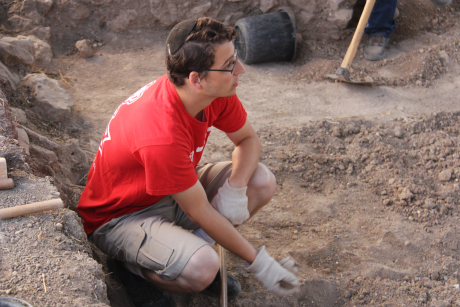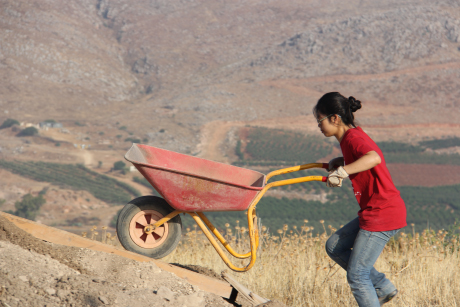Gender studies goes underground at dig in Israel
By Kathy Hovis


For scholars interested in gender studies, an archaeological dig might not sound like the most obvious research location.
But for some faculty and students at the Tel Abel Beth Maacah site in Israel this summer, the experience allowed them to take what they learned in spring classes and explore concepts in the field.
Students from Lauren Monroe’s Gender Archaeology class last spring joined with students from Azusa Pacific University, who took a course in Women in Ancient Israel, for four weeks at the dig, directed by Nava Panitz-Cohen of Hebrew University and Bob Mullins of Azusa Pacific University.
“We were interested in placing the study of gender and society on equal footing with other chronological questions being explored in the region,” said Monroe, associate professor and chair of the Department of Near Eastern Studies, who co-led the Cornell team at the site with her husband, Chris Monroe, senior lecturer and assistant director of the Cornell Institute of Archaeology and Material Studies.
“Often, with the way that data is gathered and material is published, the priority is on the larger historical questions and not on the day-to-day life of a society. So a lot of information gets lost in the course of publication.”
This summer was only the second season at the site at the border of Israel, Lebanon and Syria. Though identified as an Israelite city in the Bible, Abel Beth Maacah may have Aramean roots, perhaps as the capital of the kingdom of Maacah, Monroe said. Although the site is of historical and geographic interest, it was never excavated until last year.
Because the overall layout of the site is still being unearthed, it wasn’t possible to make detailed discoveries about men’s and women’s spaces or social interactions, Lauren Monroe said. But the group was able to put together some long-term ideas about continuing this work in the coming years.
“I was fascinated when I realized that the wall I had been taking down was built thousands of years ago, by someone working in the sun and heat, piling one enormous stone on the other,” said near eastern studies major Xinyi Chen ’17. “Suddenly the topics of the lectures, both from Professor Monroe’s course on monotheism that I took last semester and the various evening lectures, were all so relevant.”
Chris Monroe, a supervisor at one of the Abel Beth Maacah dig sites, said his area yielded some surprising discoveries.
“We were expecting to find evidence for people we know from 10th century Israel in the Bible: Israelites, Arameans, Phoenicians,” he said. “But very early on we started getting material from much earlier than that, 800 or 900 years before. So that became the focus of our area.”
His group uncovered a group of connected rooms from the Middle Bronze Age, about 1800 B.C., as well as burials that may have been on the edge of a cemetery.
“You go out into the field with all kinds of expectations and a research design, but it’s really up to what they left you and where you decide to dig that determines what you find,” he said. “You have to adjust your strategy.”
Near eastern studies major Ezra Newman ’16 said the field course helped him to understand the work of archaeologists. “People like to quote archaeological findings a lot, and I often wondered where archaeologists got their information from and how they came to certain conclusions,” Newman said.
Next year’s dig dates have been announced, and results from the 2014 season will be presented at the American Schools of Oriental Research fall meeting in San Diego.
Kathy Hovis is a writer in the College of Arts and Sciences.
Media Contact
Get Cornell news delivered right to your inbox.
Subscribe